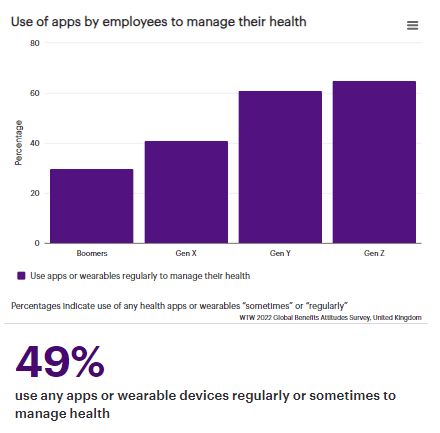Technology is playing an increasingly significant role in our lives and the same goes for healthcare. How should employers be considering this in employee benefits programme design?
Insufficient funding, staff shortages, and treatment backlogs from the pandemic continue to create mounting pressure for the National Health Service (NHS). The challenged NHS means employees are seeing more value than ever from the healthcare benefits provided by their employers.
Emerging trends in the UK healthcare market
- 93% of organisations have growing concerns around the length of NHS waiting lists
- 90% think that the late diagnosis of new conditions and the delayed treatment of existing conditions will be a serious issue impacting claims costs and benefit premiums.
Source: 2022 Emerging Trends in Healthcare Delivery Survey, United Kingdom.
As employers consider how to optimise spend and manage employee health risks, this article examines the trifold role technology has in creating truly impactful wellbeing programmes.
Telehealth services have made diagnosis and treatment more immediate
The pandemic rapidly accelerated the digitalisation of healthcare services, and from March 2020 we saw telehealth solutions being rolled out at an unprecedented pace. Patients, practitioners and employers universally recognise the significant benefits of this expansion in digital healthcare.
How telehealth is changing access to healthcare
- 78% of employees attending a virtual consultation with a specialist physician were able to get the help they needed.
- 40% of employers think they will spend more on virtual and telehealth costs in the next 5 years.
Source: 2022 Global Benefits Attitudes Survey and 2022 Emerging Trends in Healthcare Delivery survey, United Kingdom.
Across the market we are seeing the insurers competing to enhance their propositions to respond to the increasingly advanced wellbeing demands of their corporate customers. The majority of risk benefit and private healthcare plans now make a combination of virtual GP appointments, mental health treatment and physiotherapy care available to insured members in their own homes via telehealth solutions often within the standard embedded services.
This advancement of benefit propositions brings new challenges for employers: understanding which of the many available options represent best fit for their workforce, how to make optimum use of the rich health management information data now available, and how best to effectively communicate the breadth of the wellbeing services to their workforces and different eligibility pockets, whilst maximising clarity and employee appreciation.
The health wearables market is evolving at pace
In the same way that telehealth services have evolved to made diagnostics and treatment delivery more convenient and immediate – so too are wearables advancing, making symptom detection and long-term health management simpler. We are seeing health technology evolve from 'fitness tracking', into the 'health risk mitigation' and 'disease management' spaces.
This rapid evolution of health technology is set to continue and we will soon see wearable technology evolve from smartwatches to smart clothing solutions, which can gather even more detailed data and are easier for people to use.
This wearable disease flagging technology will have preventative and curative applications for both acute and chronic conditions. Over time, we will begin to see more and more instances of simple everyday wearables being used in place of complex medical instruments.
In the future we are likely to see the insurance market using data from wearables for underwriting purposes in place of time-consuming third-party reports or medical tests.
Focussing on the here and now, the immediate applications of health tech in the corporate market are its abilities to engage employees and drive behavioural change. To attract and retain the right talent, developing a modern engaging benefit programme which integrates technology is increasingly important. Our 2022 Global Benefits Attitudes Survey data shows that half of employees already use apps or wearable devices to manage their health, and this is most pronounced in the youngest generations Y and Z.
 /p>
/p>
Technological advances in cancer treatment: Immunotherapies
Technological advances in cancer treatment and the development of immunotherapies means that cancer care is becoming increasingly personalised and targeted and thus more effective. However this comes at a higher cost than less advanced treatments, and the burdened NHS is not always able to provide the latest targeted therapies. Private treatment is therefore a highly valuable additional option for those impacted by cancer and this should be considered in corporate healthcare plan design.
As treatments continue to grow in complexity, grow in efficacy but also grow in cost over the years, it will be increasingly important for employees to focus budget and effort on preventative healthcare as well as funding treatment at the point of illness, in order to effectively manage cancer risk and spend under corporate plans in the long term.
Managing cost and increasing impact
To embed successful and long-term corporate programmes which drive good long-term health, employers must look to combine health technology with communications and behavioural change science to create truly impactful change.
Engaging and effective communication programmes which drive community effort and boost social wellbeing act as a powerful catalyst for meaningful behavioural change.
The content of this article is intended to provide a general guide to the subject matter. Specialist advice should be sought about your specific circumstances.

